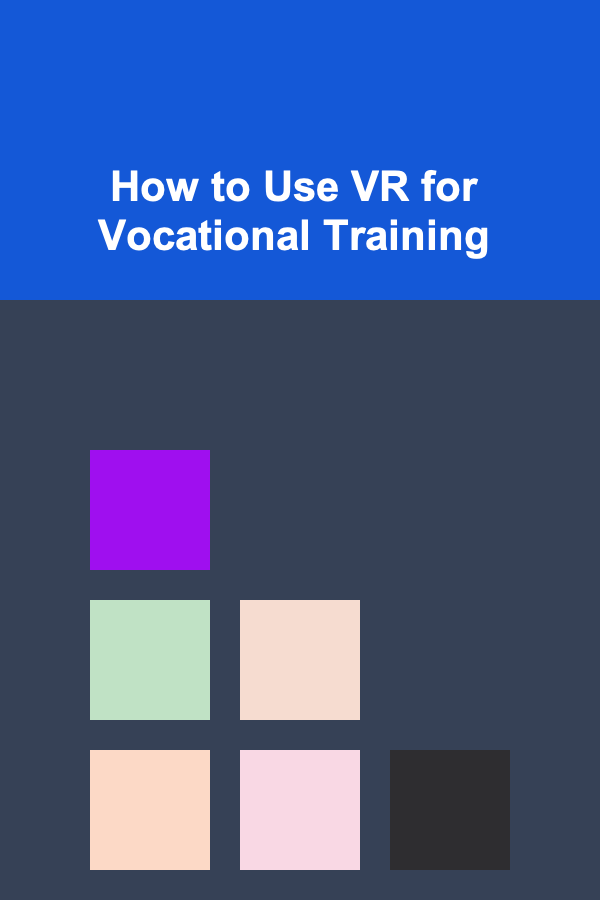
How to Use VR for Vocational Training
ebook include PDF & Audio bundle (Micro Guide)
$12.99$6.99
Limited Time Offer! Order within the next:

Virtual Reality (VR) has emerged as a transformative tool in various fields, and its application in vocational training is one of the most promising areas. VR technology has the ability to simulate real-world environments and situations, allowing trainees to engage in hands-on learning without the risks or costs associated with traditional methods. This article delves into how VR is revolutionizing vocational training, exploring its benefits, challenges, and practical applications across various industries.
Introduction to VR in Vocational Training
Vocational training aims to equip individuals with the specific skills required for particular trades, crafts, or professions. Traditionally, this has involved classroom instruction, apprenticeships, or hands-on workshops. However, as industries become more technologically advanced, there's an increasing need for more immersive, flexible, and cost-effective ways to train workers.
Virtual Reality (VR) has the potential to meet this demand. It creates immersive, interactive environments that simulate real-world scenarios, providing learners with practical experience without leaving the classroom or office. This allows learners to practice tasks that would otherwise be expensive, dangerous, or impossible to simulate in a traditional training environment.
VR-based vocational training programs can be utilized in industries such as healthcare, manufacturing, aviation, automotive, and construction, where practical experience is crucial. But how exactly does VR enhance vocational training? Let's break it down.
How VR Enhances Vocational Training
1. Immersive Learning Experiences
The primary advantage of VR in vocational training is its ability to create fully immersive learning experiences. Traditional training methods often involve lectures, textbooks, or static simulations, which can be limited in their ability to engage trainees. VR, on the other hand, places the learner in a realistic, interactive environment where they can perform tasks, make decisions, and learn from mistakes.
For example, in a medical training simulation, VR can allow students to perform surgeries or diagnose diseases in a virtual hospital environment. In a construction setting, trainees can practice operating heavy machinery or navigate complex building projects. These experiences are far more engaging and effective than simply reading about them or watching videos.
2. Safe and Risk-Free Learning
In many vocational fields, such as healthcare, construction, and aviation, the tasks being taught can be high-risk. VR provides a safe environment where learners can practice potentially dangerous tasks without any real-world consequences.
Take the example of a trainee surgeon. In traditional medical training, mistakes during a surgery could have serious consequences. However, using VR, the trainee can practice multiple surgeries and refine their skills without the risk of harming a patient. Similarly, a trainee in the construction industry can practice handling heavy equipment or working at heights without worrying about real-world accidents.
3. Cost-Effective Training
Vocational training can often be costly. Traditional methods may require expensive equipment, materials, or even access to actual worksites, which may not always be available. VR eliminates many of these costs by offering a more affordable alternative.
For example, in fields like aviation or automotive repair, the cost of physical equipment can be prohibitive. VR allows trainees to simulate the experience of working on an airplane or a car engine without the need for expensive machinery. Additionally, VR eliminates the need for transportation, lodging, or venue rentals, making it more affordable and accessible.
4. Personalized Learning and Flexibility
Every learner has different needs, and VR-based training can be tailored to suit individual preferences. VR allows trainees to control the pace of their learning, revisit lessons, or repeat exercises as necessary. For example, a learner in a VR welding simulation can practice specific techniques or revisit a challenging part of the task until they feel comfortable.
Moreover, VR allows for flexible learning. Trainees can practice anytime and anywhere, provided they have access to the necessary VR equipment. This level of flexibility is particularly advantageous for industries with a global workforce or those requiring continuous upskilling.
5. Real-Time Feedback and Analytics
Another key benefit of VR in vocational training is its ability to provide real-time feedback and track the learner's progress. Most VR systems can capture data on the trainee's actions, mistakes, and overall performance. This data can then be used to offer personalized feedback and areas for improvement.
For instance, in a VR-based welding simulation, the system might detect whether the trainee is holding the welding torch incorrectly and provide corrective feedback. Additionally, instructors can use the data to assess how well each learner is progressing and adjust the curriculum accordingly.
6. Scalability and Accessibility
VR-based training solutions can be scaled to accommodate large groups of learners, making them ideal for industries with high training demands. Whether it's a large manufacturing company or a nationwide healthcare network, VR can be deployed across multiple locations, providing standardized training to everyone involved.
Additionally, VR offers improved accessibility. Training can be conducted remotely, reducing the need for learners to travel to specific locations or attend on-site training programs. This is particularly beneficial for industries with a mobile workforce or those operating in remote areas.
Applications of VR in Vocational Training
1. Healthcare and Medical Training
The healthcare sector has greatly benefited from VR technology, particularly in medical and surgical training. Medical students and professionals can practice surgeries, diagnose conditions, and even interact with virtual patients in a risk-free environment.
For example, VR allows a trainee to perform a heart surgery simulation, where they can cut open a virtual patient, remove a tumor, or perform a heart transplant. Such immersive training experiences help medical professionals refine their skills and improve decision-making in high-pressure environments.
Beyond surgery, VR is also used for patient interaction training. Medical professionals can practice delivering difficult news or managing patient emotions, which are crucial but often overlooked skills in healthcare.
2. Construction and Engineering
The construction and engineering industries often involve dangerous work environments, requiring safety training and hands-on experience. VR has proven to be a useful tool for training workers on construction sites or heavy machinery operations.
Trainees can practice working at heights, navigating hazardous construction sites, or operating cranes, all in a safe, controlled virtual environment. VR training programs can also simulate scenarios where workers must respond to emergencies, allowing them to practice safety protocols without the risk of real-world accidents.
3. Aviation
Aviation training, particularly for pilots and air traffic controllers, has long utilized simulators. However, VR is taking this a step further by offering highly immersive flight simulations. VR allows aspiring pilots to experience flying an aircraft in different weather conditions, altitudes, and scenarios, enhancing their training experience.
Moreover, VR can be used for cabin crew training, where flight attendants can simulate various in-flight situations, including emergency evacuations, serving passengers, and handling medical emergencies.
4. Manufacturing and Automotive
In the manufacturing industry, VR can be used to train workers on operating complex machinery, conducting maintenance, or following safety protocols. For example, an automotive technician can use VR to practice repairing car engines or diagnosing faults, allowing them to become proficient before working on real vehicles.
Additionally, VR is used for assembly line training. Workers can practice assembling components in a virtual factory, honing their skills before moving to a real production environment.
5. Retail and Customer Service
Customer service and retail training can also benefit from VR. VR-based simulations can allow employees to interact with virtual customers, practice sales pitches, and refine conflict resolution skills. This is particularly useful in industries like hospitality, where interactions with customers are vital.
By simulating real-world customer interactions, retail employees can practice responding to difficult situations, handling complaints, or upselling products, all in a low-stakes environment.
Challenges and Limitations of VR in Vocational Training
While VR presents numerous benefits for vocational training, it also comes with its challenges and limitations.
1. High Initial Costs
The development and deployment of VR training programs can be expensive. High-quality VR headsets, haptic feedback systems, and sophisticated simulation software are costly investments. Additionally, specialized training staff may be needed to develop and manage VR training programs, which adds to the overall cost.
2. Technical Limitations
Despite its growing popularity, VR technology is still limited by issues such as latency, resolution, and motion sickness. In some cases, the virtual environments may not perfectly replicate the real world, which could reduce the effectiveness of training. Furthermore, not all VR experiences are intuitive, requiring extensive training for both the instructors and the learners.
3. Access to Equipment
Not all learners have access to the necessary VR equipment, particularly in less-developed regions or for individuals who cannot afford it. This can create inequalities in access to VR training, limiting its potential benefits.
4. Limited Interpersonal Interaction
While VR provides immersive, hands-on training, it may lack the social and interpersonal elements that traditional training offers. Some fields, such as healthcare, require empathy and communication skills that may not be effectively taught in a virtual environment. These skills are often better developed through in-person training or mentorship.
Conclusion
Virtual Reality is transforming vocational training by offering immersive, cost-effective, and scalable solutions across a variety of industries. Its ability to provide hands-on experience in a safe, controlled environment makes it particularly valuable in fields where risk, cost, or complexity would otherwise limit training opportunities. From healthcare to construction, VR has the potential to improve both the quality and accessibility of vocational training, empowering individuals to acquire valuable skills in a rapidly changing world.
As VR technology continues to evolve and become more accessible, it's likely that its role in vocational training will only increase. The key to successful implementation lies in addressing its challenges---such as high costs and technical limitations---while continuing to innovate and expand its applications. The future of vocational training is undoubtedly virtual, and it promises to shape the workforce of tomorrow.

How to Design a Checklist for Creating Engaging Social Media Content
Read More
How to Make the Most of a Narrow Entryway
Read More
How to Plan for Special Occasions with Kitchen Organization
Read More
How to Store High-End Shoes to Preserve Their Quality
Read More
How to Use Storytelling in Content Marketing to Connect with Your Dropshipping Audience
Read More
How To Master the Use of Symbolism in Your Stories
Read MoreOther Products

How to Design a Checklist for Creating Engaging Social Media Content
Read More
How to Make the Most of a Narrow Entryway
Read More
How to Plan for Special Occasions with Kitchen Organization
Read More
How to Store High-End Shoes to Preserve Their Quality
Read More
How to Use Storytelling in Content Marketing to Connect with Your Dropshipping Audience
Read More